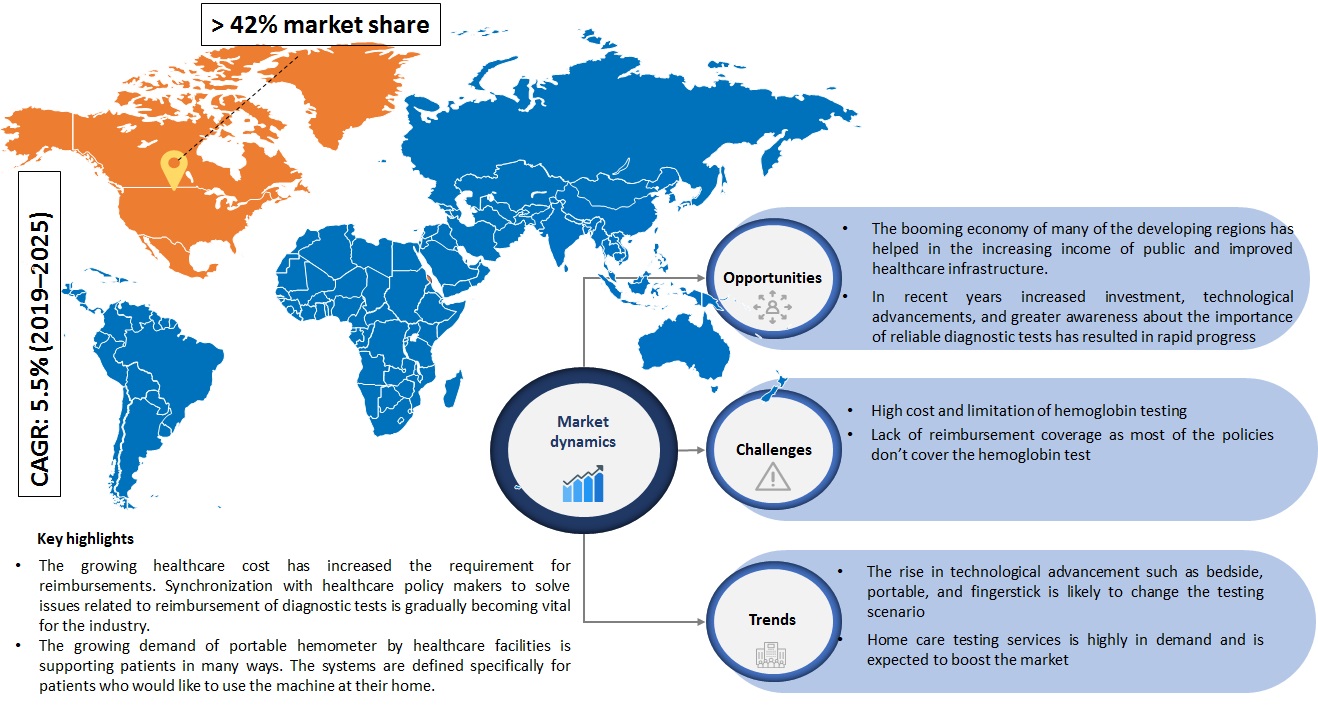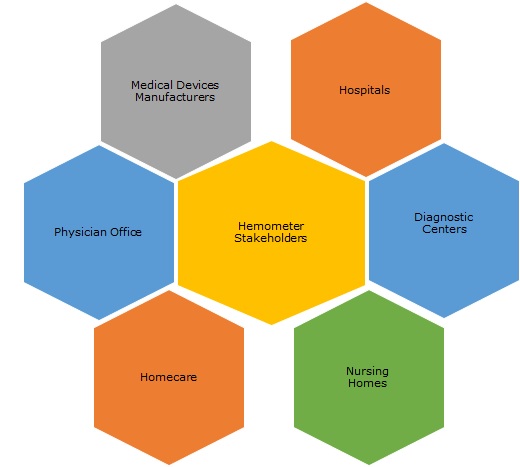
Hemometer Market By Testing Types (Laboratory Testing and Hemometer POC), Application (Anemia, Diabetes, Infection, Blood Management, and Others), and Regions (North America, Europe, APAC, and RoW) – Global Forecast up to 2025
- July, 2019
- Domain: Healthcare - Diagnostics
- Get Free 10% Customization in this Report
[69 Pages Report] This market research report includes a detailed segmentation of the global hemometer market by testing types (laboratory testing and hemometer POC), by application (anemia, diabetes, infection, blood management, and others), and by regions (North America, Europe, APAC, and RoW).
Hemometer Market Research Overview
Infoholic Research predicts that the global hemometer market will grow at a CAGR of 5.5% during the forecast period 2019–2025. Hemoglobin is one of the major proteins that carry oxygen throughout the body. The increasing incidence of chronic diseases such as anemia, diabetes, fatigue, poor health, and extreme weight loss is driving the hemometer testing market. Most of the patients undergo blood checkup especially hemoglobin as it determines many medical conditions as blood carries many nutrients with it. Hemoglobin test is useful for diagnosing a wide range of diseases, especially anemia and diabetes. The market is classified into a different type of testing procedure: laboratory testing and hemometer POC and by application types: anemia, diabetes, infection, blood management, and others. Traditional laboratory testing with automated blood analyzers are dominating the market and the portable/handheld hemometer POC devices are expected to see a lucrative growth in the market. Hemoglobin analyzers are the standard device that are routinely used in laboratories to diagnose these conditions. In recent years, with the advent of point-of-care testing has revolutionized the hemometer devices market and the technology is continuously evolving with new kind of devices that includes various kinds of small devices for PoCT that range from the humble so-called dipstick to the sophisticated small cartridge devices. Sysmex’s XN-Series of hematology analyzers (XN-1000, XN-2000, XN-3000, and XN-9000) and EKF’s DiaSpect Tm are some of the hemometer devices available in the market.

The newer techniques in hemometer testing are increasing the adoption of both laboratory testing and POC devices. These testing are performed in every basic medical set up and is widely used in blood centers, diagnostic centers, hospitals etc. The availability of POC devices is maximizing the adoption due to cost-effectiveness and usage in the outpatient department in rural and urban areas. Further, the government initiatives taken by the developing nations is expected to drive the demand for innovative hemometer devices. The accuracy, safety, and usability among patients have helped in many field settings done by medical colleges, government programs, and community programs to measure and understand the blood-related disorders in many regions. The device is popular in all healthcare facilities and the increased use of hemometer devices have bought a significant clinical purpose for treating anemia and diabetes.
Hemometer Market by Testing Types:
- Laboratory Testing
- Hemometer POC
Laboratory testing segment was valued over $1.1 billion in 2018 and is estimated to grow with a similar trend during the forecast period. Hematology analyzers are commonly used to measure hemoglobin levels in laboratories to diagnose anemia and diabetes. Hematology analyzers are computerized, highly specialized machines that count the number of different types of RBC and WBC, blood platelets, hemoglobin, and hematocrit levels in a blood sample.
Hemometer POC segment is expected to grow at a CAGR of more than 7% during the forecast period. The rise in technological advancements and increase preference for hemometer in recent years is accelerating the growth in coming years. Cost-effective, safety, accuracy, and smart POCT devices are boosting the market.
Hemometer Market by Application:
- Anemia
- Diabetes
- Infection
- Blood Management
- Others
In 2018, diabetes and anemia led the maximum revenue in the hemometer laboratory testing market with large volumes of diagnostics and treatments globally.
Hemometer Market by Regions:
- North America
- Europe
- APAC
- RoW
In terms of regional analysis, the market is dominated by North America due to advancements in technology, presence of leading vendors, increase in regulatory reforms, and changes in reimbursement policies. Europe is followed by North America and has similar potential in growth and development. APAC is the most focused and fastest-growing region due to vast opportunities for vendors to establish their presence. The factors such as the presence of a large pool of chronic patients, increasing blood-related disorders, support from the government, and health & wellness programs are expected to boost the market growth. APAC, Latin America, and RoW are the most focused and fastest-growing regions due to vast opportunities. Moreover, most of the countries in these regions are focusing on increasing healthcare expenditure from the government as there is excess growth in medical technology in Brazil, China, India, Mexico, Indonesia, Iran, South Korea, Nigeria, and South Africa.
Competitive Analysis – The competition among leading vendors is due to the availability of a wide range of hemometer with different brand names in the market. This provides an opportunity for healthcare consumers (diagnostic facilities) to choose products based on brand, price, features, model, and discount. Most of the vendors are focusing on providing bundling product models for increasing their sales and having a larger market share in terms of revenue. Many vendors have established their market presence globally and focus strongly on marketing and selling their products by competing with small and regional vendors. Therefore, the competition among the vendors is expected to hinder the market growth, yet the market will have more products developed and launched. Most of the vendors are primarily focusing on research and development to offer fast technological progress. Manufacturers including major and mid-sized companies in the hemometer market are competing with newer products, advanced features, quality, safety, and efficacy.
The competition is growing among the healthcare service providers – hospitals, diagnostic centers, and other healthcare facilities where the customer groups are being consolidated for purchasing products. Diversified product portfolio companies, large volume product buyers (hospitals), and primary competitors (single product manufacturers) have strong market positions in certain segments and regions due to their wide range of products and services they offer. New competitors, especially from Asia, are also taking the competition to a new high with quality, safety, and efficacy of the product over the past few years.
Key Vendors:
- Bio-Rad Laboratories Inc
- Siemens Healthineers
- Abbott Laboratories
- Danaher Corporation
- Hoffmann-La Roche Ltd.
- EKF Diagnostics Holdings Plc
- Thermo Fisher Scientific, Inc.
- Nikkiso Co., Ltd.
- Diazyme Laboratories, Inc.
Key Competitive Facts:
- The market is highly competitive with all the players competing to gain the market share. Intense competition, rapid advancements in technology, frequent changes in government policies, and the prices are key factors that confront the market.
- The requirement of high initial investment, implementation, and maintenance cost in the market are also limiting the entry of new players.
- Responding to competitive pricing pressures specific to each of our geographic markets.
- Protection of proprietary technology for products and manufacturing processes.
Benefits – The report provides complete details about the usage and adoption rate of hemometer systems. Thus, the key stakeholders can know about the major trends, drivers, investments, vertical player’s initiatives, and government initiatives towards the medical devices segment in the upcoming years along with details of the pureplay companies entering the market. Moreover, the report provides details about the major challenges that are going to impact the market growth. Additionally, the report gives complete details about the key business opportunities to stakeholders in order to expand their business and capture the revenue in specific verticals and to analyze before investing or expanding the business in this market.
Key Takeaways:
- Understanding the potential market opportunity with precise market size and forecast data.
- Detailed market analysis focusing on the growth of the hemometer devices.
- Factors influencing the growth of the hemometer
- In-depth competitive analysis of dominant and pureplay vendors.
- Prediction analysis of the hemometer industry in both developed and developing regions.
- Key insights related to major segments of the hemometer
- The latest market trend analysis impacting the buying behavior of the consumers.
Key Stakeholders:

1 Industry Outlook
1.1 Industry Overview
1.2 Industry Trends
1.3 Total Addressable Market
2 Report Outline
2.1 Report Scope
2.2 Report Summary
2.3 Research Methodology
2.4 Report Assumptions
3 Market Snapshot
3.1 Market Definition – Infoholic Research
3.2 Segmented Addressable Market
3.3 Trends in the Hemometer Market
3.4 Related Markets
3.4.1 Point of Care Testing
3.4.2 Infectious Disease Diagnostics
3.4.3 Molecular Diagnostics
4 Market Outlook
4.1 Market Segmentation
4.2 PEST Analysis
4.3 Porter 5(Five) Forces
5 Market Characteristics
5.1 DRO – Market Dynamics
5.1.1 Drivers
5.1.1.1 Increase in diabetic and anemic population globally
5.1.1.2 Rising obesity levels
5.1.1.3 Huge surge in the aging population
5.1.2 Opportunities
5.1.2.1 Increasing adoption of point of care testing
5.1.2.2 Growth opportunities in developing countries
5.1.3 Restraints
5.1.3.1 Lack of reimbursement coverage and accuracy issue of the device
5.1.3.2 Limitations of hemoglobin testing
5.2 DRO – Impact Analysis
5.3 Key Stakeholders
6 Test Types: Market Size and Analysis
6.1 Overview
6.2 Laboratory Testing
6.3 Hemometer Point of Care Testing
7 Application: Market Size and Analysis
7.1 Overview
7.2 Anemia
7.3 Diabetes
7.4 Infection
7.5 Blood Management
7.6 Others
8 Technology: Market Size and Analysis
8.1 Overview
8.2 Ion-exchange High-performance Liquid Chromatography
8.3 Immunoassay
8.4 Boronate Affinity Chromatography
8.5 Others
9 Regions: Market Size and Analysis
9.1 Overview
9.2 North America
9.3 Europe
9.4 Asia Pacific
9.5 Rest of the World
10 Competitive Landscape
10.1 Overview
11 Vendors Profile
11.1 Bio-Rad Laboratories Inc.
11.2 Siemens Healthineers
11.3 Abbott Laboratories
11.4 Danaher Corporation
11.5 F. Hoffmann-La Roche Ltd.
12 Companies to Watch For
12.1 EKF Diagnostics Holdings plc
12.2 Thermo Fisher Scientific, Inc.
12.3 Tosoh Corporation
12.4 Diazyme Laboratories, Inc.
12.5 BioSynex
12.6 BioMedomics, Inc
13 Annexure
13.1 Abbreviations
Research Framework
Infoholic research works on a holistic 360° approach in order to deliver high quality, validated and reliable information in our market reports. The Market estimation and forecasting involves following steps:
- Data Collation (Primary & Secondary)
- In-house Estimation (Based on proprietary data bases and Models)
- Market Triangulation
- Forecasting

Market related information is congregated from both primary and secondary sources.
Primary sources
involved participants from all global stakeholders such as Solution providers, service providers, Industry associations, thought leaders etc. across levels such as CXOs, VPs and managers. Plus, our in-house industry experts having decades of industry experience contribute their consulting and advisory services.
Secondary sources
include public sources such as regulatory frameworks, government IT spending, government demographic indicators, industry association statistics, and company publications along with paid sources such as Factiva, OneSource, Bloomberg among others.
